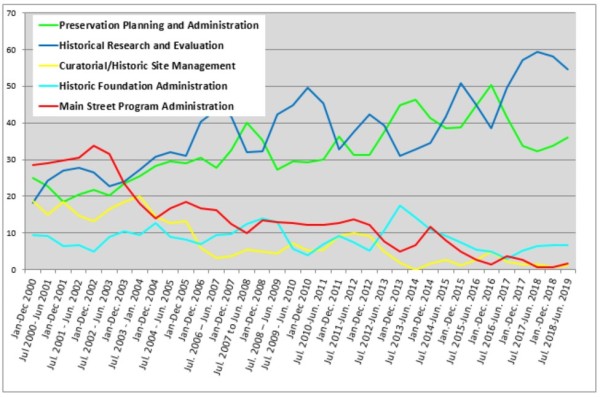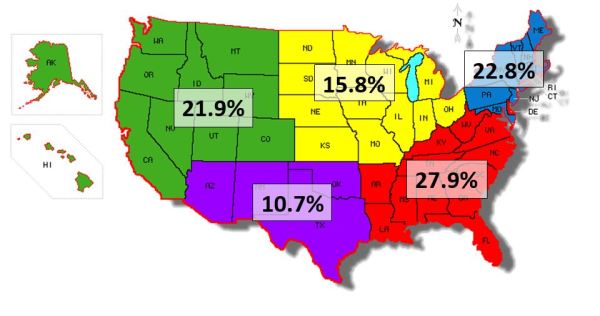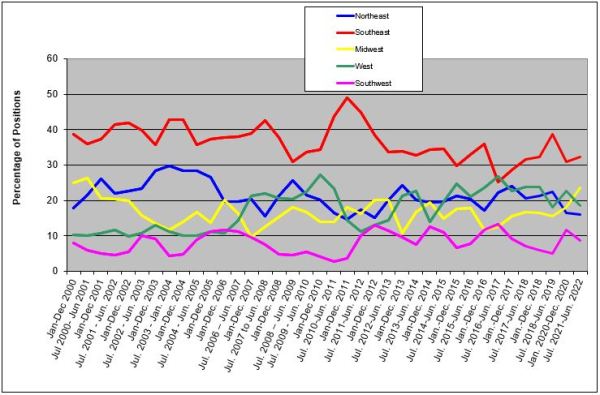Careers
CAREER INFORMATION OVERVIEW
See also the article, “Careers for Historians: Architectural Historians,” from the North Carolina Museum of History.
SURVEY OF PROFESSIONAL CAREER OPPORTUNITIES IN ARCHITECTURAL HISTORY
The following information, maintained by the architectural history department, is intended to provide an overview of professional academic careers in architectural history outside academia based on a continuing review of the most recent position announcements in the field and information provided by employers. Comments or career opportunity information may be sent to Dr. Tom Gensheimer at tgenshei@scad.edu.
 The present data was compiled July 2022 from 315 position listings published July 2021 through June 2022.
The present data was compiled July 2022 from 315 position listings published July 2021 through June 2022.
Trends in Number of Advertised Positions 2000-2022:

Current Distribution of Positions by General Categories of Employment:
Note: The five general categories listed here are described below.
 Preservation planning and administration: 32.3 percent of listings
Preservation planning and administration: 32.3 percent of listings
Historical research and evaluation: 59.3 percent of listing
Historical site management and curatorship: 1.3 percent of listings
Historic foundation administration: 6.5 percent of listings
Main Street program administration: 0.6 percent of listings
Trends in Position Distribution 2000-2019:

Current Geographic Distribution of Positions (July 2022):
 Northeast: 22.8 percent of listings
Northeast: 22.8 percent of listings
Southeast: 27.9 percent of listings
Midwest: 15.8 percent of listings
West: 21.9 percent of listings
Southwest: 10.7 percent of listings
Trends in Geographic Distribution 2000-2022:

Education Requirements
A degree in architectural history is applicable to all position announcements employed in this survey. Nearly half of the announcements specifically named a degree in architectural history, usually along with other related disciplines; the remainder named an unspecified degree in a relevant field. The minimum education requirement was a bachelor’s degree but most listings state a preference for a graduate degree. The majority of listings in preservation planning and administration and in historical research and evaluation conformed with U. S. Department of the Interior definitions contained in 36CFR61. This specifies a master’s degree in an appropriate discipline or alternatively, a bachelor’s degree plus two years of relevant experience. Most listings in these categories stated a preference for a graduate degree and additional experience.
Skills and Specialized Knowledge
See individual descriptions of career categories.
Salaries
Following are averages of salary ranges as listed in position announcements, excluding additional benefits, rounded to the nearest $500. The upper salary level listed in such announcements may represent qualifications exceeding the minimum requirements specified for the position.
* Positions requiring a B.A. in architectural history or a related field and minimal experience: $42,000-$75,000.
* Positions requiring an M.A. in architectural history or a related field or a B.A. plus two years of relevant experience (36CFR61), M.A. frequently preferred. Most positions specify an additional two to three years of experience: $39,500-$89,000.
* Positions requiring or preferring an M.A. in architectural history or a related field with a minimum of three to five years of experience: $50,000-$103,000.
* Positions requiring an advanced degree and more than five years of experience: $56,000-$170,000.
General Categories of Employment
In broad terms, most non-academic positions in architectural history can be grouped into one of the following five categories.
1. Preservation Planning and Administration
This employment category is similar to Main Street management listed below and is interrelated with the following historical research and evaluation category. Professionals in the present field are primarily concerned with the planning and administration of preservation programs, providing technical support to the community and attending public meetings. Positions in this category are typically more office based and require more interpersonal skills than the following category.
Principal employers are state and local government agencies, including historic preservation offices and nonprofit organizations.
Duties include:
* development and implementation of historic preservation and historic zoning programs
* identifying and evaluating historic resources
* processing applications for historic property designation
* Providing technical assistance to the community and attending public meetings
* coordinating government programs with community groups
Skills and experience:
* writing and communication skills, especially interpersonal skills
* organizational skills, computer database management
* ability to interpret architectural plans and surveys
* knowledge of federal and local regulations
2. Historical Research and Evaluation
This field is the counterpart to preservation planning and administration, above. It involves completing field surveys, conducting research and completing the reports reviewed by state and local government agencies. Compared to preservation planning and administration this field is less office oriented, requiring more on-site work and travel.
Principal employers are architectural firms, cultural resource firms and government agencies.
Duties include:
* site investigation and documentation
* archival research on historic structures
* writing reports and applications for historic designation
* ensuring compliance with federal and local regulations
* often includes some travel
Skills and experience
* research and writing skills
* photography skills
* surveying/rendering skills
* knowledge of federal and local regulations
3. Historic Site Management and Curatorship
This field is analogous with museum curatorship but often includes aspects of historical research and evaluation, above and/or historic foundation management and administration, below.
Principal employers are local governments or private, nonprofit organizations.
Duties include:
* management of volunteers and staff
* development of educational programs
* research and documentation
* collections management
* public presentations
Skills and experience:
* museum experience/knowledge of museum practices
* documentation and research skills
* knowledge of history and historic furnishings
* public speaking skills
* supervisory skills
4. Historic Foundation Management and Administration
Positions in this field are rarely entry level and generally require experience in nonprofit organization administration coupled with a background in architectural history. In many cases duties include those of historic site management as well.
Principal employers are historic foundations.
Duties include:
* fundraising
* coordination of events
* budget management
* editing/publishing of foundation literature
* management of volunteers and staff
Skills and experience:
* strong writing, oral communication and interpersonal skills
* nonprofit fundraising experience
* supervisory experience
5. Main Street Management
Professionals in this field implement and manage downtown revitalization and preservation programs known as Main Street programs. These programs are assisted by the National Trust for Historic Preservation, National Main Street Center. In addition to sharing many of the activities in the preservation planning and administration category, Main Street managers are also involved with marketing and fundraising.
Principal employers are nonprofit organizations.
Duties include:
* identifying and evaluating historic resources
* processing applications for historic property designation
* coordinating revitalization plans with business organizations
* marketing downtown assets to new business interests
* Providing technical assistance to the community
Skills and experience:
* strong writing, oral communication and interpersonal skills
* knowledge of Main Street program practices
* nonprofit management experience
* supervisory experience
* knowledge of federal and local regulations




This is a great survey. Thanks for the information. I wonder if such a survey could be done for historic preservation consultants?
LikeLike
A great source of information and the charts are very helpful. I wish I could take this and find a contractual job in historic preseration/cultural resource management where I live……Memphis, TN. I have a MA and have not found but one contractual job since graduaton three years ago. Any suggestions????
LikeLike
Dear Ms. Renforth,
Feel free to contact Prof. Karl Schuler in our department who compiles the data for suggestions as to where you can find position listings. His email is kschuler@scad.edu.
Thanks for visiting our website.
Robin Williams
LikeLike
awesome resource, I will definitely be checking into this as I continue to research ways to get into the Architectural History field, thanks a bunch! If anyone has positions listings in the New England/ Northeast Region, I’m looking for just about anything!
Thanks,
Jared
LikeLike
Hi Jared, I run a job website for preservationists and historians. You can search the site by category or state. These links might be helpful to you! Architectural History: http://histpres.com/category/job/architectural-history. Massachusetts: http://histpres.com/tag/massachusetts. Or send me an email at info@histpres.com for more specific assistance. Best to you.
LikeLike
Great information! I am an architectural history consultant in Tucson AZ. I got most of my experience “hands-on” by doing research with a local architectural firm. I’ve been involved in several surveys, “obituaries” of buildings being torn down (some listed in historic neighborhoods), and belong to a modern architecture group. I am looking to make a move to Rocky Mount NC and hope to be able to get involved with the historic groups there and the Main Street Program. Thanks for the great site!
LikeLike
This is important information for Architectural Historians, and yes, there has been a survey for Historic Preservationists (consultants, specialists, etc.). In 10/2011, my website HISTPRES.COM, presented at the National Trust conference on trends in preservation employment. We analyzed 1436 jobs over 6/2010 to 6/2011, and interviewed 524 preservationists.
Here are some take-aways:
The most sought after skill by employers based on job descriptions is Management/Administration and Education/Interpretation, while the majority of those interviewed thought their best skills were Architectural History/Historical Research. Be aware that schools are not necessarily teaching what is requested, but you can tailor your professional explorations to those skills.
The bulk of the opportunities were split between the Northeast and Southeast, specifically NYC, Boston and DC. Being geographically open is your absolute best bet while looking for employment.
And specifically for Architectural Historians on this SCAD website…Architectural History positions are some of the most popular on our website so we post every position that we find. In our sample year there were 51 positions posted for Architectural Historians, 55% for private employers, started at $37,000 salary, and were primarily located in the Southeast.
Finally, there is a growing number of Architectural History and Historic Preservation-degree granting programs to the point that there are approximately 500 new Master’s every year (in HP). I don’t have the numbers for AH, but I do not believe that there are more jobs as job seekers in this field.
I am happy to share additional information and email you the full PDF presentation, just comment here or email me at info@histpres.com.
LikeLike
what about positions and salaries in academia for those w/ a MA or MFA in Architectural History
LikeLike
The survey does indicate the positions and salaries for students with an M.A. Since our program is the only one to offer the M.F.A., it is not indicated in the positions listings as a requirement, but as a Master’s degree meets (if not exceeds) the expectations of an M.A.
LikeLike
I’ve just modified the statement about degree expectations to make it more explicit that the M.A. listed was in Architectural History or a related field. Thanks for the question.
LikeLike
If you want to change roles or get ahead in your career, it’s important that you know how to identify and pursue opportunities that are a good match for your interests, skills, and circumstances. –
Most interesting write-up on our own internet site
<,http://www.caramoantourpackage.com
LikeLike
Aw, this was an exceptionally good post. Taking a
few minutes and actual effort to produce a great article… but what can I say… I procrastinate a lot and never seem to get
anything done.
LikeLike
I am an architectural historian from the Netherlands Europe, currently in South Africa. My field of interest is shared built heritage (heritage from the colonial era). Doing research is my speciality. Are there research positions in the USA for Europeans?
LikeLike
Thanks for sharing the most recent employment statistics. Best. Chrissy
LikeLike
This is an excellent and valuable resource. Thank you for publishing data through 2015.
LikeLike
Very helpful, thanks so much. A note to my fellow preservation professionals: I graduated with a Masters in 2012 from a good school and couldn’t find work for quite some time. Don’t be disheartened! I eventually had to move from Philadelphia to Florida for work, and I’m really happy that I made the move. You definitely need to be flexible in this field, especially if you live in the Northeast. I found it to be much more competitive up there. The Southeast is really booming right now for our field. Check out Indeed.com for jobs and the Preservenet database in addition to HistPres. If you’re looking for government work in the preservation field, try FEMA. The environment can be sort of stressful but the benefits and pay are outstanding. Good luck!
LikeLike
The information are useful. I am a structural engineer from India. My works involves the structural audit and analysis of heritage buildings. Are there any job opportunities available in USA for structural engineers in historical conservation field?
LikeLike
how do i use it. can you help me?
LikeLike